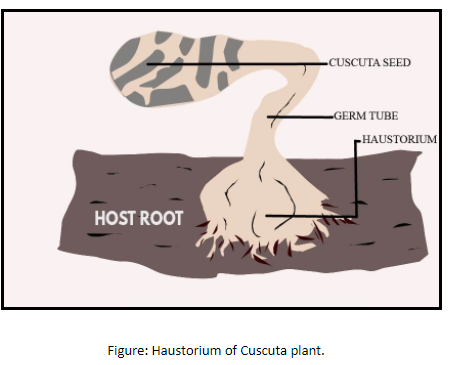
Haustorial root is present in
(a)Zea Mays
(b)Cactus
(c)Cuscuta
(d)Monotropa
Answer
584.7k+ views
Hint: Haustoria is the portion of the root apex in the parasitic plant or parasitic fungus that helps to penetrate the host's tissues for getting the necessary nutrients for the growth of the parasitic plant.
Complete answer:
Cuscuta is a parasitic plant because its leaves are reduced, so least photosynthesis occurs within this plant. Hence, it has to depend on other plants for its survival. After it attaches itself to a plant, it wraps itself around it. If the host has food beneficial to this plant, it produces haustoria that inserts itself into the vascular system of the host. The original root of the Cuscuta then dies in the soil. The dodder can grow and attach itself to a number of plants.

Additional Information: -Cuscuta is also known as the dodder plant.
-Cuscuta is the total stem parasitic.
-Cuscuta plant is an ectoparasite that lives on the outside of the host.
-Dodder is found on a vast variety of plants, including several agricultural and horticultural crop species, such as alfalfa, lespedeza, flax, clover, potatoes, chrysanthemum, dahlia, helenium, trumpet vine, ivy, and petunias.
-Zea mays are the maize, cactus is the xerophyte and Monotropa is a flowering plant, and its roots have a mycorrhizal association and lack haustoria.
So, the correct answer is, ‘Cuscuta.’
Note: In tropical areas, with a hot humid climate, it can grow more or less continuously and may reach high into the canopy of shrubs and trees; in cold temperate regions, it is an annual plant and is restricted to low vegetation that can be reached by new seedlings.
Complete answer:
Cuscuta is a parasitic plant because its leaves are reduced, so least photosynthesis occurs within this plant. Hence, it has to depend on other plants for its survival. After it attaches itself to a plant, it wraps itself around it. If the host has food beneficial to this plant, it produces haustoria that inserts itself into the vascular system of the host. The original root of the Cuscuta then dies in the soil. The dodder can grow and attach itself to a number of plants.

Additional Information: -Cuscuta is also known as the dodder plant.
-Cuscuta is the total stem parasitic.
-Cuscuta plant is an ectoparasite that lives on the outside of the host.
-Dodder is found on a vast variety of plants, including several agricultural and horticultural crop species, such as alfalfa, lespedeza, flax, clover, potatoes, chrysanthemum, dahlia, helenium, trumpet vine, ivy, and petunias.
-Zea mays are the maize, cactus is the xerophyte and Monotropa is a flowering plant, and its roots have a mycorrhizal association and lack haustoria.
So, the correct answer is, ‘Cuscuta.’
Note: In tropical areas, with a hot humid climate, it can grow more or less continuously and may reach high into the canopy of shrubs and trees; in cold temperate regions, it is an annual plant and is restricted to low vegetation that can be reached by new seedlings.
Recently Updated Pages
The number of solutions in x in 02pi for which sqrt class 12 maths CBSE

Write any two methods of preparation of phenol Give class 12 chemistry CBSE

Differentiate between action potential and resting class 12 biology CBSE

Two plane mirrors arranged at right angles to each class 12 physics CBSE

Which of the following molecules is are chiral A I class 12 chemistry CBSE

Name different types of neurons and give one function class 12 biology CBSE

Trending doubts
One Metric ton is equal to kg A 10000 B 1000 C 100 class 11 physics CBSE

Explain zero factorial class 11 maths CBSE

What is 1s 2s 2p 3s 3p class 11 chemistry CBSE

Discuss the various forms of bacteria class 11 biology CBSE

State the laws of reflection of light

An example of chemosynthetic bacteria is A E coli B class 11 biology CBSE




